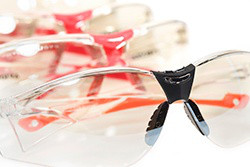 Work-related eye injuries are quite common. They can also be quite damaging to employees’ health and draining to your organization’s bottom line.
Work-related eye injuries are quite common. They can also be quite damaging to employees’ health and draining to your organization’s bottom line.
According to OSHA and Prevent Blindness:
- Over 2,000 people injure their eyes at work each day
- 1 in 10 of these injuries require one or more missed workdays
- 10-20% of work-related eye injuries will cause temporary or permanent vision loss
- Eye injuries cost over $300 million per year in lost production time, medical expenses, and worker compensation.
But with proper selection and use of eye and face protection, many of these injuries could have been prevented. In fact, the American Optometric Association says “safety experts and eye doctors believe the right eye protection can lessen the severity or even prevent 90 percent of these eye injuries.”
Personal protective equipment (PPE) is of course not the only solution. You should also use guards and engineering controls to reduce eye injuries.
What Types Of Hazards Threaten Workers’ Eyes?
In order to understand what PPE is appropriate for your workers, you need to first assess the hazards. What types of tasks are workers conducting? What materials, tools, or objects are in their vicinity? Consider the hazards posed by other workers who are nearby, machinery, and even falling debris.
OSHA categorizes eye hazards into the following 5 categories:
- Impact – Flying objects such as large chips, fragments, particles, sand, and dirt. This could happen during tasks such as chipping, grinding, machining, masonry work, wood working, sawing, drilling, chiseling, powered fastening, riveting, and sanding.
- Heat – Anything emitting extreme heat. This could happen during tasks such as furnace operations, pouring, casting, hot dipping, and welding.
- Chemicals – Splash, fumes, vapors, and irritating mists. This could happen during tasks such as acid and chemical handling, degreasing, plating, and working with blood.
- Dust – Harmful dust. This could happen during tasks such as woodworking, buffing, and general dusty conditions.
- Optical Radiation – Radiant energy, glare, and intense light. This could happen during tasks such as welding, torch-cutting, brazing, soldering, and laser work.
Selecting The Right Eye Protection
Should your employees be wearing safety spectacles, safety googles, face shields, welding helmets, or even full-face respirators? It depends on the hazards they are susceptible to. So once you’ve identified the hazards using the resources above, you’re ready to select the appropriate eye protection.
OSHA’s Eye and Face Protection eTool is a great place to go. The tool will walk you through the hazards and identify which types of eye protection are appropriate for each situation.
Keep in mind that there may be multiple hazards present in a workplace at one time. If this is the case, you should select PPE that will protect your workers from the highest level of hazard for each type.
Make Sure Eye Protection Fits Properly
Once you’ve identified the hazards and selected the appropriate eye protection, you must then ensure it fits properly. Poorly fitting protection isn’t going to be as effective.
OSHA requires the following:
- Fitting of goggles and safety spectacles should be done by someone skilled in the procedure. Prescription safety spectacles should be fitted only by qualified optical personnel.
- Devices with adjustable features should be fitted on an individual basis to provide a comfortable fit that maintains the device in the proper position.
- Eye protection from dust and chemical splash should form a protective seal when fitted properly.
- Welding helmets and face shields must be properly fitted to ensure that they will not fall off during work operations.
Maintenance And Care
To ensure eye and face protection remains effective; educate your employees on the proper care and maintenance of the PPE. Where and how should they be stored? How should they be cleaned and disinfected? What are the signs of equipment that needs replacement? The OSHA standards answer these questions and more. Use this information to train your employees.
Eye protection works! The proper selection, fit, maintenance, and care, along with the implementation of guards and engineering controls, can help prevent eye injuries and improve workplace safety.




